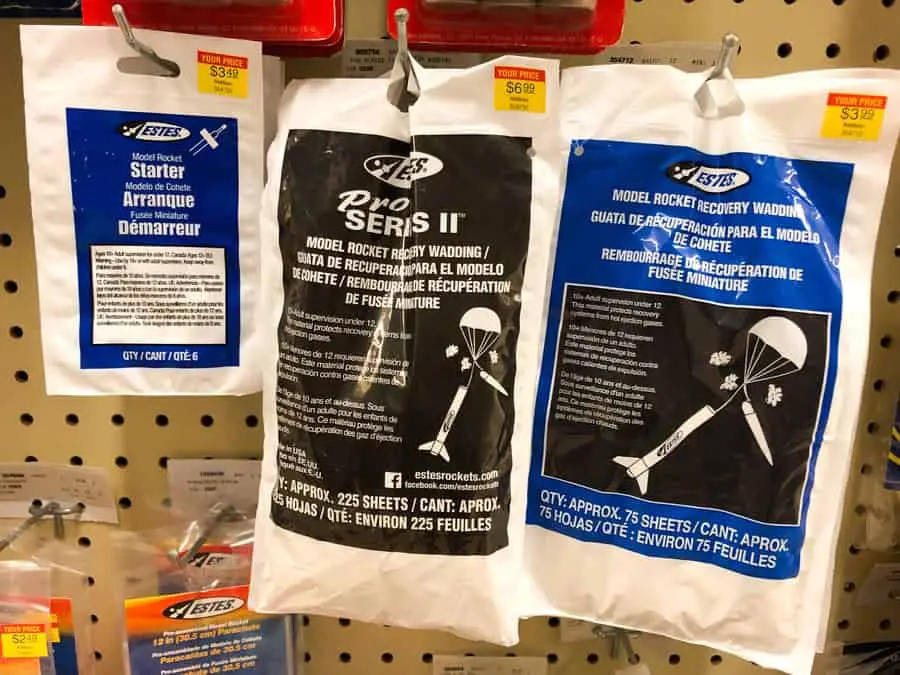
Most aspects of model rocketry have reusable or DIY alternatives to help keep the costs of launching rockets low because no one wants to launch a rocket just once. Wadding isn’t expensive, but after several launches the costs can add up, especially for high powered rocketry.
What are some model rocket wadding alternatives? As an alternative to recovery wadding, you can use a baffle, fire resistant crepe paper or fire resistant cellulose insulation. There are also several DIY methods of making recovery wadding that cost significantly less than store bought wadding.
Not only will some DIY options for recovery wadding save you a few dollars here and there, it’s good to know what kinds of homemade options you might have for wadding in the event you run out but don’t want to cancel an upcoming launch.
Are you still using the standard Estes controllers for your launches?
We just built our own beautiful launch controllers that make launches SO much more fun, and we documented EVERY single step and item purchased and put it into a step-by-step course that teaches you how to do the exact same thing.
Click here to learn more about how you can build your own launch controllers!

Alternatives to Model Rocket Recovery Wadding
Before we discuss the alternatives to model rocket recovery wadding, we need to understand the purpose of recovery wadding and how it works.
Recovery wadding is a thin, fire resistant tissue-like paper used to create a buffer between the ejection charge of a model rocket’s engine and the recovery system.
Without this buffer, the parachute or recovery system could become damaged by the hot gases issuing out of the motor. Additionally, the recovery system could catch fire and cause the rocket to catch fire or become damaged when it hits the ground if the recovery system is compromised.
Launching a rocket without recovery wadding or insufficient wadding is unsafe for the recovery system, the rocket, the flyer, and any bystanders.
To use recovering wadding, you simply ball up a few sheets and stick them into the rocket’s body before you put in the recovery system. The recovery wadding should create a barrier that is twice as thick as the diameter of the rocket’s barrel.
Shortly after the rocket begins its descent back to the ground, the recovery system is activated by an ejection charge located at the top of the motor. This ejection charge shoots powerful, hot gas through the rocket that causes the recovery system to be shot from the rocket.
The recovery system can then do the job of slowing the rocket’s descent and allowing it to hit the ground without damage. If you fly without recovery wadding of some sort, you won’t be flying rockets for very long.
Reusable Recovery Wadding
Reusable recover wadding, also called parachute protectors, have been around for some time. They cost between $5 and $10 depending on the size of the protector, but they can be used over and over again.
Many people prefer to use them, especially if they are launching high power rockets, as the amount of recovery wadding starts to add up on those higher diameter rockets.
Baffle
A baffle is a small device that must be installed in the rocket’s tube between the motor and the recovery system.
This device creates a buffer between the ejection charge and the recovery system, filtering out fiery particles and allowing the gas to cool before it reaches the sensitive recovery system.
This drawback of this alternative is that it is a permanent solution to one single rocket. Each rocket you use will have to be equipped with its own baffle. Depending on how many rockets you launch, this can be costly and time consuming.
Items You Can Use Instead of Recovery Wadding
Years of model rocket flyers trying to reduce the cost of their launches or finding themselves in a pinch without enough recovery wadding has led to some ingenious, and downright odd, alternatives to recovery wadding.
Before selecting an item to use in place of recovery wadding consider first the flammability of the item and its environmental impact. If it can catch on fire, it will not do its job. In addition, whatever you use will fall to the ground. Make sure it is biodegradable or very easily recovered.
Here is the list of items people have reportedly used for recovery wadding:
- Cellulose insulation
- Flame resistant crepe paper
- Flame resistant paper pom pom decorations
- Iceberg Lettuce
- Cabbage
- Repurposed welding jackets
Here is a list of things you should NOT use, that were proposed by people in various forums:
- Pink insulation
- Dryer lint
- Cardboard
- Any type of paper that has not been treated for flame resistance
Cellulose Insulation
By far the most commonly used alternative to recovery wadding is cellulose insulation. Cellulose is made from recycled paper and is treated with boric acid to be fire resistant. Boric acid is a natural substance, but it is also poisonous. Just be careful while handling it and don’t use it around children that might put it in their mouth.
Cellulose insulation can be purchased at any home improvement store, it is biodegradable, and it is cheap. You can buy 19 pounds of cellulose insulation for under $10, which is more than enough for hundreds of launches.
Crepe Paper
Crepe paper, like the kind used for party streamers is another popular choice. After a birthday party, many model rocket enthusiasts will save this stuff to use as recovery wadding. It can also be purchased inexpensively at most stores including the dollar store.
The only word of caution against crepe paper is to actually make sure it is flame resistant. Not all crepe paper has been treated for flame resistance. If you use the wrong stuff, your recovery system could get damaged, and your rocket could catch on fire.
You can test the crepe paper by putting a flame to a small piece of it in a safe location. It should smolder, but no flame should appear.
Do It Yourself Alternatives to Recovery Wadding
If you’re looking for wadding that looks and acts a little more like the wadding you buy at the hobby shop, then I have got some great alternatives for you. All of these methods work by taking some sort of thin paper and making it flame resistant.
The result is recovery wadding that is almost indistinguishable from the store-bought version.
Paper Towels and Baking Soda
The below video details the process for turning paper towels and baking soda, two commonly found household items, into recovery wadding. It even tests regular recovery wadding and wadding made through this method under flame so you can see how it reacts.
For this DIY alternative you will need…
- Paper towels, preferably 2-ply
- Baking soda (sodium bicarbonate)
- ¼ cup measuring cup
- 1 tsp
- A clear bowl for mixing
- A bowl for dunking
- A way of hanging wet paper towel to dry like a clothes drying rack
If you plan to do a larger batch of DIY recovery wadding, you would need a large mixing bowl and larger measuring tools. The water to baking soda ratio will remain the same.
Step-by-Step Instructions
- Mix 1 tsp of baking soda into ¼ cup of water in the clear bowl until the baking soda is completely dissolved.
- Allow the baking soda to sit until the water becomes clear. There will be a little baking soda left in the bottom of the bowl that was unable to be incorporated with the water. This is expected, and desirable as it indicates that the water is saturated with baking soda.
- Dump the water-baking soda mixture into another bowl trying not to get that left-over baking soda into the bowl.
- Set aside the clear mixing bowl and dunk one paper towel into the water-baking soda mixture. Allow the water to soak all the way through the paper towel before removing.
- Hang the wet paper towel over something to dry. This can take up to 24 hours.
- Once the paper towel is dry, you can separate the 2-ply paper towel into two pieces and then cut them to a similar size as the wadding you are used to.
Toilet Paper and Baking Soda
This method is also shown in the same video as the method above. It will take longer before you can use the wadding in this method (about 2 weeks), but you will get enough to last you a very long time. Continue reading for the full instructions.
For this DIY alternative, you will need…
- A roll of toilet paper
- Baking soda (sodium bicarbonate)
- 1 cup measuring cup
- 1 tsp
- Clear bowl for mixing
- A container with a tight lid that can fit a roll of toilet paper
Step-by-Step Instructions
- Mix about 2 cups of water with 8 tsp of baking soda. There needs to be enough water to cover most of the roll of toilet paper.
- Allow the liquid to become clear. You will get some baking soda that does not dissolve into the liquid. This is expected.
- Once again, pour the water-baking soda mixture into the container without dumping the extra baking soda from the bottom into the container.
- Place the toilet paper into the water-baking soda mixture, and let it soak.
- After a few minutes, you should be able to pull out the cardboard center of the toilet paper and discard it.
- If your toilet paper is not completely covered by the liquid, you may need to tip it upside down for a few minutes and allow the other side to soak up the mixture.
- The toilet paper should get completely saturated to the point where there is still liquid left in the container, and it can’t soak up anymore.
- Put it on a dry surface like a plate where it can dry for a few weeks.
- When it has completely dried, you may have to peel off and discard the outer layer if it is crusted over with baking soda.
- Peel off a piece of the toilet paper beneath and it should feel a lot like the recovery wadding you are used to purchasing.
Toilet Paper and Borax
The toilet paper and borax method is almost exactly like the paper towel and baking soda method. The only difference is that you would replace baking soda with borax and paper towels with toilet paper, and you need to use warm or hot water and 4 teaspoons of borax to ½ cup of water.
The drawback of this method is that borax is poisonous, and many people do not have borax sitting around their houses anymore, at least not as many that probably have a box of baking soda stashed away somewhere.
The easiest, most foolproof, and cost-effective solution to traditional disposable recovery wadding is to purchase cellulose insulation. It is simple, you can’t mess it up, and it is inexpensive.
Build Your Own Launch Controllers
Don’t forget! You can ditch the stock controllers and confidently build your own from scratch using our step-by-step instructions and exact materials list! We promise this will make your launch experience 10x better, and using our course License to Launch you can be 100% confident you’ll be able to finish this project and be super proud of what you’ve built! Here’s a sneak peek below.
